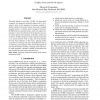INTERSPEECH
2010
13 years 6 months ago
2010
The amount of available Thai broadcast news transcribed text for training a language model is still very limited, comparing to other major languages. Since the construction of a b...
INTERSPEECH
2010
13 years 6 months ago
2010
This paper describes a new toolkit - SCARF - for doing speech recognition with segmental conditional random fields. It is designed to allow for the integration of numerous, possib...
INTERSPEECH
2010
13 years 6 months ago
2010
This paper presents a new approach to language model construction, learning a language model not from text, but directly from continuous speech. A phoneme lattice is created using...
COLING
2010
13 years 6 months ago
2010
An unsupervised discriminative training procedure is proposed for estimating a language model (LM) for machine translation (MT). An English-to-English synchronous context-free gra...
COLING
2010
13 years 6 months ago
2010
We present a framework where auxiliary MT systems are used to provide lexical predictions to a main SMT system. In this work, predictions are obtained by means of pivoting via aux...
ICDAR
2009
IEEE
13 years 9 months ago
2009
IEEE
Building recognition systems for historical documents is a difficult task. Especially, when it comes to medieval scripts. The complexity is mainly affected by the poor quality and...
ICDAR
2009
IEEE
13 years 9 months ago
2009
IEEE
In this paper we investigate the use of linguistic information given by language models to deal with word recognition errors on handwritten sentences. We focus especially on error...
EMNLP
2009
13 years 9 months ago
2009
Semantic Role Labeling (SRL) has proved to be a valuable tool for performing automatic analysis of natural language texts. Currently however, most systems rely on a large training...
EMNLP
2009
13 years 9 months ago
2009
We develop a general method to match unstructured text reviews to a structured list of objects. For this, we propose a language model for generating reviews that incorporates a de...
EMNLP
2009
13 years 9 months ago
2009
In this paper we propose a novel statistical language model to capture long-range semantic dependencies. Specifically, we apply the concept of semantic composition to the problem ...





